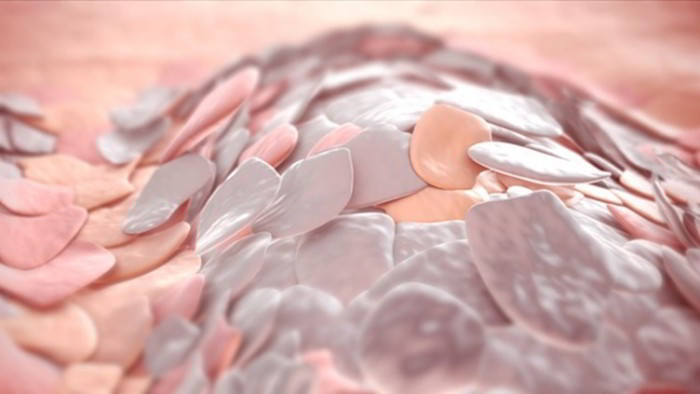About 1 in 50 individuals suffers from psoriasis. The reddish, thickened, scaly rash that qualifies this state has a tendency to flare up at different times throughout life.
If psoriasis affects many parts of the human body usually the fronts of the knees, the backs of the elbows, trunk, scalp and back, it may cause physical suffering together with humiliation in public expected to shedding skin scales. The nails can be called for as can the joints. Psoriasis often runs in families and diseases and stress can trigger an attack.
In a psoriasis plaque, new skin cells are created about ten times quicker than standard and at a substantially quicker speed than dead cells are shed. The skin cells pile up to form thick, creamy coloured scales. The cause isn’t understood, but psoriasis frequently has a genetic element. A flare up of psoriasis may be triggered by illness, injury or stress. Specific drugs, like antidepressants, particularly lithium, antihypertensive, beta blockers and antimalarial drugs, can trigger psoriasis in a number of people. Drinking alcohol can worsen existing psoriasis.
What Are The Kinds?
There are four primary kinds of psoriasis, each of which has a distinctive look. Some Individuals may be influenced by greater than one kind. Here are the features of each kind.
1. Plaque Psoriasis
- Places called plaques, comprising thickened, reddish skin with creme-coloured scaly surfaces, typically appear on the knees, elbows, lower back and scalp, behind the ears and at the hairline.
- There’s occasional itching.
- Nails become discoloured and covered with little pits. In serious instances, the nails thicken and lift away from the nail beds.
- Plaques tend to continue for weeks or months and may recur intermittently.
2. Guttate Psoriasis
This type most generally affects children and teens, often happening after a bacterial throat infection.
- Numerous coin-shaped, pink patches of scaly skin, each about 1cm (%in) across, appear mostly on the back and torso.
- There’s generally occasional itching.
These symptoms generally disappear in 4-6 months or recur, but more than half’ of those changed after develop another type of psoriasis.
3. Pustular Psoriasis
- Little blisters full of pus may appear Suddenly on the palms of the hands and the soles of the feet.
- There may be extensive regions of reddish, inflamed and acutely painful skin.
- There may be some thickening and scaling of the inflamed regions.
4. Inverse Psoriasis
Aged individuals are generally influenced by such a psoriasis in which big, damp, reddish regions grow in skin folds, rather than prevalent body regions. The rash frequently changes the crotch, the skin under the breasts and occasionally the armpits. Inverse psoriasis generally clears up with treatment but may recur.
Are There Complications?
About 1 in 10 individuals with psoriasis of any kind develops a type of arthritis that usually changes the fingers or knee joints. In pustular and exfoliative psoriasis, a substantial reduction of cells from the surface of the skin can result in decrease of protein, Diseases and high temperature; if it’s left untreated, the illness can be life threatening.
What Might Be Done?
External Treatment
- Psoriasis is usually treated with emollients to soften the skin. Other common treatments are preparations including coal Pitch or a material called anthralin. These reduce inflammation and scaling. Coal tar and anthralin are powerful but have an unpleasant Odor and can stain clothes and bed linen. Anthralin should be applied to affected regions Simply because it can irritate healthy skin.
- Instead, your physician may prescribe a External preparation containing the vitamin D derivative calcipotriol to be used twice a day. It’s no odor, will not stain skin or Clothing, and is usually successful within around four weeks. You should follow the guidance of your physician or dermatologist because this treatment shouldn’t be used on the face or in the creases of the skin. Topical corticosteroids are often used, sparingly.
Specific Treatments
- For extensive psoriasis that doesn’t React to external treatments, healing exposure to ultraviolet (UV) light is frequently Successful. PUVA therapy involves using UV Treatment jointly with psoralen, an oral drug That’s taken before the ultraviolet light treatment and helps make the skin more sensitive to the effects of light.
- Routine, brief doses of sunshine regularly help clear up psoriasis. Average exposure of affected regions to sun can be valuable during the summertime.
- In really serious cases of pustular psoriasis, for which external preparations may not be Successful, treatment with oral or intravenous drugs may be advocated. The drugs used for this treatment include retinoids, the anticancer drug methotrexate and the immunosuppressant drug cyclosporin. Nevertheless, both retinoids and methotrexate can cause abnormalities in a growing fetus. Because of this, you must not take either of these drugs if you’re pregnant or you’re Intending to have a kid.
- Chinese herbs in pill, infusion and cream Type can be quite successful and are constantly worth attempting.
- The Dead Sea treatment maintains a three-year remission. No one understands how it works but it’s not only as a result of submergence in the Dead Sea. Fellow patients add support similar to group Treatment. But then you need to travel to the Dead Sea for the treatment.
What Is The Outlook?
Although there isn’t any treatment for psoriasis, treatment usually alleviates the symptoms and helps many individuals with the state lead a Ordinary life. If psoriasis is a long term issue, you may need to join a self-help group or the Psoriasis Association.
Self-Help
It may help reduce your consumption of meat, animal fats, sugar and booze and increase consumption of fibre – that’s, wholegrain cereals, fruit, vegetables, cooked dried beans and peas, and nuts and seeds. Eat more oily fish, especially mackerel, sardines, herring and salmon. An oatmeal bath will help soothe irritated skin. Set 1 kg (2lb) of oatmeal in cheesecloth bags in a hot bath and soak for a quarter hour. Use your treatment later.



